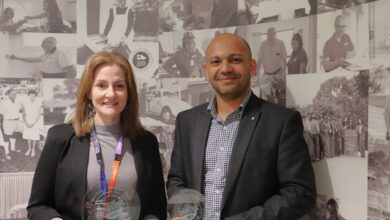At the heart of good communication
For health researcher Tricia McCabe developing strong clinical relationships with indigenous patients is first and foremost about building relationships of trust. She tells Linda Belardi.
Researchers from the University of Sydney and James Cook have launched a series of online teaching resources targeting improved communication between indigenous patients and health professionals.
The semi-scripted video vignettes document six everyday experiences of indigenous Australians interacting with the health system and encourage students to identify and overcome common misunderstandings and barriers to effective communication.
Lead researcher, Tricia McCabe said the video scenarios captured authentic encounters developed from qualitative research undertaken with indigenous communities and participating Aboriginal actors.
“We asked our focus groups to tell us their stories of when they had seen health professionals. When it had gone well, and when it had gone badly. From these insights we scripted six vignettes that feature Aboriginal actors talking to, or sometimes clashing with, real-world health professionals.”
Overwhelmingly the lesson for all health professionals was the importance of relationships, McCabe said, who is also senior lecturer with the Faculty of Health Sciences at the University of Sydney.
“For nurses, as for all health professionals particularly in acute settings, we can have a task focus. But a task focus is probably less helpful to long-term healthcare than a focus on relationships.”
McCabe said health professionals had to put the person, not the routine, at the centre.
“What our research participants told us was that the tasks could wait. While the task will be important, developing trust and building a relationship, even simply by introducing yourself and giving explanations rather than instructions was just as important.”
For McCabe, one of the most revealing insights was the degree to which some indigenous people assumed racist causes for poor service delivery.
“If you have a history of being treated poorly, you will assume that when things go wrong that it’s just more of the same. For example, you and I might think that if there is a long wait in emergency it might be the result of a systemic failure.
Whereas, our indigenous actors they certainly attributed that behaviour to some residual racism. And that was relatively shocking. It just demonstrates the importance of understanding the assumptions we and others make.”
Good communication with indigenous people often means repairing the bonds of institutional mistrust, she said.
Equalising the power imbalance between patients and professionals also emerged as an important theme and essential to building a trusting relationship.
As a patient, a person is often asked to provide personal information about their family history and lifestyle without knowing very much about the professional providing the care. This creates an unequal relationship where only one person has the right to ask questions, she said.
McCabe said it was important for nurses to share information by giving clear explanations about who they were and why the wanted to know particular information.
“The idea of a power imbalance came up specifically as an issue of trust and respect. But without a reciprocal sharing of information that trust or respect cannot be established.”
Because relationship building is so important, McCabe said it was critical to avoid “virtual medical tourism” and was concerned by the impact of the constant churn of temporary clinical placements in indigenous communities.
While the need to place students in clinical settings was important for learning, it had to be balanced with the needs of indigenous patients.
“I want my students to have exposure to indigenous patients to build their confidence and competence as health professionals. But what is also important here is the relationship of the clinical educator with the community.
“If the clinical educator is there for the long-term, then the students will be tolerated because the clinical educator has developed that relationship of trust with the community.”
While the primary goal of the multi-media resources developed over three years is to improve intercultural communication, the resources can also be used when teaching about basic interview and case history taking skills.
McCabe said it was necessary to talk about indigenous patients within the context of broader health issues, as well as part of the closing the gap agenda.
The resources are currently being trialled by undergraduate and postgraduate students and in post-professional training. n
The Byawala project resources are publicly available. Go to http://www.byalawa.com/
Email: [email protected]




